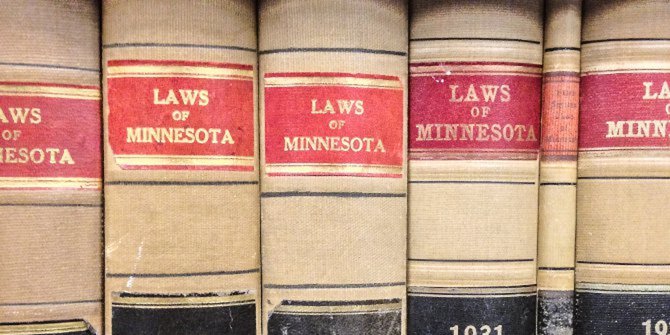 Why make the same mistakes as those who have gone before you? In new research into state lawmaking, Rachael K. Hinkle finds that legislators often put that principle into practice. She finds that when the Supreme Court rules that a state’s law is constitutional, it is 27 percent more likely that another state will adopt that same type of law. In addition, using software originally designed to detect plagiarism, she also uncovers that these other states will borrow up to 7 percent of the law’s text, a probability which triples if a state’s own federal circuit court declares the law to be constitutional.
Why make the same mistakes as those who have gone before you? In new research into state lawmaking, Rachael K. Hinkle finds that legislators often put that principle into practice. She finds that when the Supreme Court rules that a state’s law is constitutional, it is 27 percent more likely that another state will adopt that same type of law. In addition, using software originally designed to detect plagiarism, she also uncovers that these other states will borrow up to 7 percent of the law’s text, a probability which triples if a state’s own federal circuit court declares the law to be constitutional.
We often hear people say that it’s important to learn from your mistakes. I always figured it’s even better to learn from someone else’s mistakes. Evidence shows that state legislators do just that. They are less likely to pass a law when the same type of law has been declared unconstitutional by the US Supreme Court, and they are more likely to pass a type of law that has been declared constitutional by federal appellate courts. The lessons learned extend to the construction of laws as well. In new research, I find that legislators borrow more specific language from existing policies that have been declared constitutional.
One of the key strengths of a federal system of government is that each of the states can learn from one another’s experiences, both good and bad. When we elect state legislators to office, we do not expect them to re-invent the proverbial wheel for every policy decision. Time is a scarce resource in their job, just as it is for all of us. Efficiency becomes key. While these ideas are as old as the US Constitution itself, emerging technologies provide new paths for investigating the nuances of legislative borrowing.
A particularly efficient way to make policy is to seek out successful policies from other jurisdictions and borrow not only the ideas contained therein, but even use the same phrasing. Borrowing text does not just save time drafting a law. It can have a much more important benefit. State laws must comply with the US Constitution. When a state law is struck down in the federal courts because this requirement was not met, the time state legislators spent on the law is wasted. State lawmakers can minimize this risk by finding a law from another state that the federal courts have said is constitutional and using the same language in their own law. And they can learn from mistakes as well. If another law is declared unconstitutional, it only makes sense to avoid using the text of that law.
Lawmakers can choose to spend their time on a variety of issues. The success or failure of a particular type of law in the courts can help them make the decision about whether to work on a new law at all. If the courts have struck down another state’s attempt, it makes less sense to invest time trying to pass a law. Conversely, if such laws have been upheld it will be less risky for lawmakers to devote time and effort to getting a law passed.

I looked for evidence of such patterns using a collection of all state laws passed from 1973 to 2010 that address six different types of abortion regulation. Using these laws and information on all federal appellate court rulings regarding their constitutionality, I evaluated whether court rulings make adoption of a particular type of law more or less likely in a given year and whether new laws are drafted differently based on such court rulings. I measured how much text a new law borrows using WCopyFind, software originally designed to detect plagiarism. This software calculates the percentage of the phrasing in the new law that is borrowed from each relevant existing law. Focusing on re-use of language patterns provides more direct evidence of actual influence than simply relying upon the existence of a particular type of law and a subsequent enactment of the same general type of legislation in a different state.
My results vary for different types of courts, but overall there is broad evidence that court rulings of constitutionally influence both adoption of laws and their content. When the Supreme Court declares that a law is constitutional, the probability that another state will adopt the same type of law in a given year is 0.019, a 27 per cent increase over the 0.015 probability when there is no court ruling. In general, about 3 per cent of the text of a new law is borrowed, but when the Supreme Court has ruled a previous law constitutional, that number more than doubles to 7 per cent. The most remarkable finding is that a state will borrow a whopping 21.1 per cent of the text from a law that has been declared constitutional by the state’s own federal circuit. Such a ruling is particularly informative to state legislators because any ruling with respect to a state law becomes binding precedent for all other states in the same circuit.
That states learn from one another is no surprise. That they consider the success or failure of policies in federal courts is quite natural. What is novel is using plagiarism software to study the process of policy diffusion, which allows a nuanced analysis that is easily scalable to large numbers of documents. My finding on the overlap between two documents is also nicely intuitive. What’s more, the available software is both free and very user-friendly. Calculating overlap between two documents is barely more difficult than downloading a document from an e-mail. For all of these reasons, I hope that examination of borrowed text becomes a staple of policy diffusion research.
This article is based on the paper, ‘Into the Words: Using Statutory Text to Explore the Impact of Federal Courts on State Policy Diffusion’ in the American Journal of Political Science.
Featured image credit: Tony Webster (Flickr, CC-BY-2.0)
Please read our comments policy before commenting.
Note: This article gives the views of the author, and not the position of USAPP – American Politics and Policy, nor the London School of Economics.
Shortened URL for this post: http://bit.ly/1l6ZxdA
_________________________________
 Rachael K. Hinkle – University at Buffalo, SUNY
Rachael K. Hinkle – University at Buffalo, SUNY
Rachael K. Hinkle earned her Ph.D. in Political Science from Washington University in St. Louis and her J.D. from Ohio Northern University. She is currently an assistant professor in the Department of Political Science at the University at Buffalo, SUNY. Her research agenda focuses on judicial politics with particular attention to gleaning insights into legal development from the content of judicial opinions through the use of computational text analytic techniques.






